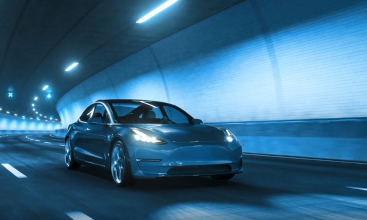Automotive innovation:
5 trends driving the industry
- Electric vehicles will grow in popularity as the electrification of heavier cars and trucks becomes more feasible.
- The rise of autonomous driving will reshape expectations of mobility and improve accessibility.
- Manufacturers will keep EV battery production closer to home, rethinking supply chains to gain greater control.
May 23, 2023
From the advent of mass car production in the early 1900s to the rise of modern electric vehicles in the 2000s, the automotive industry has transformed dramatically over the last century. In the future, the landscape will continue to evolve, fueled by changing consumer behavior and the development of new technologies.
“During the COVID-19 pandemic, automakers had to wrestle with various factors, including the chip shortage and rising energy costs. But now, as the pandemic recedes and the industry looks a bit more normal, there will be increased focus on megatrends,” said Ryan Brinkman, Head of the U.S. Autos & Auto Parts research team at J.P. Morgan.
What does the road ahead look like for the automotive industry?
The future of electric vehicles
Electrification will continue to gather pace over the next few years. The share of electric vehicles (EVs) across EU5 countries (France, Germany, Italy, Spain and the U.K.), the U.S. and China reached 29.4% in October 2022, with the EU5 market leading the way.
EV penetration in EU5 countries
EV penetration rose overall in 2022, reaching 47% for the year vs. approximately 36% in 2021.
“We expect the EV market in Europe to reach approximately 45% in 2025,” said Jose Asumendi, Head of European Automotive Research at J.P. Morgan. “It should then climb further to around 50% by 2030, driven by a robust EV launch pipeline and investment in infrastructure to develop the fast charging network in Europe.”
What about the rest of the world? In the U.S., sentiment is changing and according to a Reuters poll, over one-third of Americans would now consider buying an EV for their next model. “The U.S. has lagged behind when it comes to EVs as American consumers generally drive bigger vehicles. The heavier the vehicle, the more obstacles need to be overcome for electrification to make sense. For instance, the battery needs to be larger to power the vehicle,” said Brinkman.
However, recent advancements in vehicle lightweighting and battery energy density are making the electrification of heavier vehicles more feasible. “We’re already starting to see electric pickup trucks from manufacturers such as GM, Ford and Tesla,” noted Brinkman. “There’s the sense that all vehicle categories and classes will be transitioning toward green.”
In addition, EVs will become more affordable as they gain economies of scale, and could even cost the same as their petrol or diesel counterparts by the middle of the decade. Financial subsidies are helping, too: In the U.S., for example, the Inflation Reduction Act of 2022 offers tax credits for EV purchases, as well as for the purchase and installation of charging assets or infrastructure. “Soon, there will higher demand for EVs for financial reasons, and there will no longer be a need to incentivize the consumer or the manufacturer,” said Brinkman.
The rise of autonomous cars
In the future, the rise of autonomous driving will reshape consumers’ expectations of mobility. More than a means of transport, the self-driving car will become a “third place” — an environment outside the home or office that is conducive for relaxation and interaction.
“In an autonomous vehicle, consumers don’t have to pay attention to the road as much. This opens up more opportunities for them to do other things, such as sleeping or streaming content,” said Brinkman. In the U.K., for instance, consumers in self-driving cars will soon be allowed to watch television on built-in screens under proposed updates to the Highway Code.
Self-driving technology will also make vehicles more accessible. As Brinkman noted, consumers with disabilities will be able to use autonomous robo-taxis, giving them greater freedom and independence.
These kinds of vehicles already exist — for instance, retail giant Amazon is testing a fleet of self-driving robo-taxis in California. “However, we believe the commercial rollout of Level 4 and 5 fully autonomous robo-taxis is likely to be delayed beyond earlier expectations,” said Brinkman. “While major players have been conducting tests for some time now, widespread adoption still remains further out, particularly in the context of frequent mishaps and glitches during testing.”
In addition to robo-taxis, higher-level autonomous cars could soon be a reality. Mercedes-Benz is launching its Level 3 autonomous driving system in the second half of 2023 — this means vehicles will be able to self-drive, but human intervention may still be required. “Tesla has been the biggest disruptor in this space to date, but Mercedes-Benz is overtaking it,” said Asumendi. “The Mercedes-Benz vehicles will require less driver input and will surpass Tesla’s current autonomous driving technologies.”
Localization of automotive supply chains
Major changes are taking place in the manufacture of integral car components, namely batteries. The European battery market is moving toward localized production and shoring up battery supply as demand soars, with the aim of attaining 100% electric mobility by 2035.
The drive to keep battery production in-house and closer to home is partly due to pricing and partly due to control. Batteries comprise around 40% of the price of a vehicle; as such, manufacturers want to cut costs and better manage their supply chain, avoiding the kind of disruption experienced during the COVID-19 pandemic.
Will it be enough? “By 2030, we expect the share of battery electric vehicles (BEVs) to make up approximately 40% of the market, and the share of plug-in hybrid vehicles (PHEVs) to reach approximately 10%, making EVs the predominant technology in Europe,” said Asumendi. “Even at these levels, increased European battery capacity means there should not be any major supply issues. There are no battery shortages on the horizon in Europe.”
In the U.S., there is also a push toward domestic EV battery production. This has largely been fueled by the Inflation Reduction Act, which includes rules around critical materials and battery component assembly that encourage domestic production.
“An EV battery contains various critical minerals including nickel, copper and lithium, and the majority of these are imported,” said Asumendi. “The Inflation Reduction Act sets strict requirements around where materials are extracted and processed. In addition, 40% of battery components must be manufactured or assembled in North America, increasing to 80% after 2026.”
Unless these requirements are adhered to, EVs will no longer be eligible for tax credits, so manufacturers are keen to comply. This will change the dynamics of the automotive supply chain, and major original equipment manufacturers (OEMs) including VW, Mercedes and Stellantis have already finalized plans for local battery plants in the U.S. and Canada. The influx of new manufacturing plants will allow the region to ramp up battery production and dramatically increase capacity.
Total battery capacity in North America
Total battery capacity in the U.S. will go from around 139.5k gigawatt hours (GWh) in 2022 to over 930k GWh by 2035.
The growing popularity of ride-sharing
According to figures from Statista, global ride-sharing penetration is expected to reach 18.3% by 2027, up from 17.4% in 2023. While individual car ownership will decrease as a result, this is unlikely to weigh on new vehicle sales — assuming that the total number of miles driven by the general population remains the same. “With increased ride-sharing, there will be similar amounts of wear and tear placed on fewer vehicles. In turn, vehicles may need to be replaced more frequently,” explained Brinkman.
On the other hand, there will be more ramifications for the used vehicle market. “We believe ride-sharing is more likely to impact used vehicle sales, as vehicles will see fewer transfers across owners given declines in useful life,” said Brinkman. “This will, however, affect only a fraction of the customer base in dense urban areas.”
Improvements in car safety technology
“Cars have been getting safer for many years, but primarily as a result of passive safety systems that protect you when you’ve already been in an accident — think seatbelts and airbags,” said Brinkman. In the last decade or so, additional safety features such as automatic emergency braking, electronic stability control and lane departure warning systems have hit the market.
Looking ahead, J.P. Morgan Research predicts road safety will be further enhanced by the move toward autonomous driving, as this could reduce or even eliminate collisions that result from human error. “After all, 97% of road accidents are caused by humans, and only 3% by mechanical failure,” noted Brinkman. “Also, as the vehicle fleet becomes increasingly connected — and as cars talk to the infrastructure and to one another — it should become safer.”
Related insights

RESEARCH
Inflation and the auto industry: When will car prices drop?
Updated: February 22, 2023
J.P. Morgan Research explores the factors driving up vehicle prices and when inflationary pressures will abate.

RESEARCH
The future is electric
November 17, 2020
In the past few years, the auto industry’s transformation has accelerated around the world.

RESEARCH
Driving into 2025: The future of electric vehicles
October 10, 2018
The car industry is undergoing a radical transformation, with most carmakers agreeing the next 10 years will bring more change than the two previous decades.
This communication is provided for information purposes only. Please read J.P. Morgan research reports related to its contents for more information, including important disclosures. JPMorgan Chase & Co. or its affiliates and/or subsidiaries (collectively, J.P. Morgan) normally make a market and trade as principal in securities, other financial products and other asset classes that may be discussed in this communication.
This communication has been prepared based upon information, including market prices, data and other information, from sources believed to be reliable, but J.P. Morgan does not warrant its completeness or accuracy except with respect to any disclosures relative to J.P. Morgan and/or its affiliates and an analyst's involvement with any company (or security, other financial product or other asset class) that may be the subject of this communication. Any opinions and estimates constitute our judgment as of the date of this material and are subject to change without notice. Past performance is not indicative of future results. This communication is not intended as an offer or solicitation for the purchase or sale of any financial instrument. J.P. Morgan Research does not provide individually tailored investment advice. Any opinions and recommendations herein do not take into account individual client circumstances, objectives, or needs and are not intended as recommendations of particular securities, financial instruments or strategies to particular clients. You must make your own independent decisions regarding any securities, financial instruments or strategies mentioned or related to the information herein. Periodic updates may be provided on companies, issuers or industries based on specific developments or announcements, market conditions or any other publicly available information. However, J.P. Morgan may be restricted from updating information contained in this communication for regulatory or other reasons. Clients should contact analysts and execute transactions through a J.P. Morgan subsidiary or affiliate in their home jurisdiction unless governing law permits otherwise.
This communication may not be redistributed or retransmitted, in whole or in part, or in any form or manner, without the express written consent of J.P. Morgan. Any unauthorized use or disclosure is prohibited. Receipt and review of this information constitutes your agreement not to redistribute or retransmit the contents and information contained in this communication without first obtaining express permission from an authorized officer of J.P. Morgan. Copyright 2023 JPMorgan Chase & Co. All rights reserved.